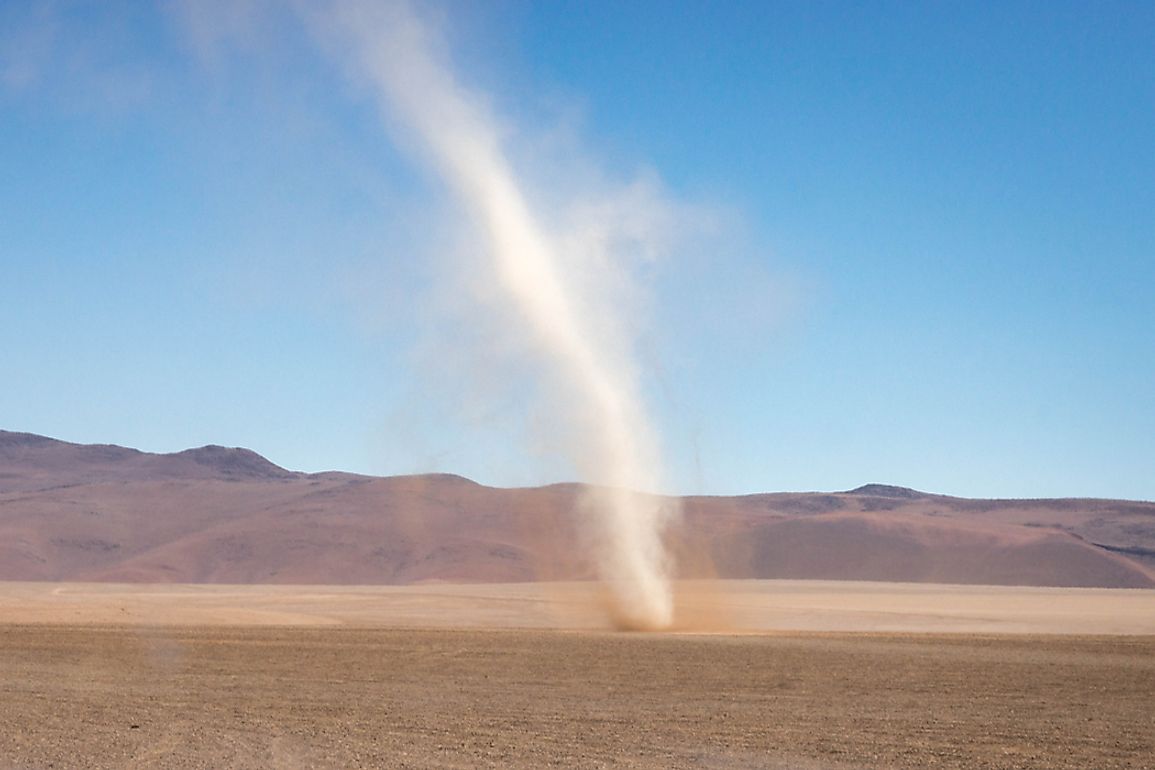What Is A Dust Devil?

Dust devils are well-formed, robust, and long-lived whirlwinds whose width ranges from 1.6 feet to 16 feet. The height of these dust devils varies from 3.3 feet to 3,280 feet. Dust devils are generally harmless, but on rare incidences, they can be huge enough to pose a threat. Just like tornadoes, dust devils are vertically oriented revolving wind columns. Dust devils are whirlwinds which occur during fair weather whose intensity does not even come close to that of a tornado. Tornadoes are connected with a supercell thunderstorm and mesocyclone.
Formation of Dust Devil
Dust devils are formed when a hot air packet near the ground rises rapidly through the cold air above it creating an updraft which swirls under the right conditions. As the air rises, the hot air column is stretched vertically, thereby moving closer to the rotational axis which intensifies the swirling effect. The secondary flow causes the other hot air to move horizontally inwards to the lower part of the newly created vortex. As it progresses to the lower parts of the vortex to replace the rising air, the spinning effect becomes stronger and self-sustaining.
A fully-formed dust devil is a funnel-like column through which hot air moves circularly and upwards. Once the hot air reaches the top, it cools and starts descending outside the vortex as its being replaced by the rising warm air. The descending cold air serves as a balance against the swirling hot-air and stabilizes the system.
The spinning effect on the ground produces a forward motion, and the dust devil sustains itself longer by moving around. Eventually, cold air will be sucked into the vortex, and when this occurs, the dust devil disappears. Cold air gets sucked in when the speed of the dust devil reduces or when it moves on a place when the surface temperature is lower.
Factors Contributing to the Formation of Dust Devils
Dust devils are more likely to occur when the following conditions are met. They usually form on flat, barren territory with little to no wind, lightly cloudy or clear skies, and cool temperatures.
1) Flat, barren territory: The flat landscape (tarmac or desert) increases the chances of the hot air being close to sandy or dusty conditions thus making it possible for the particles to be sucked into the vortex. The particles make it possible for it to be visible, but they are not necessary for vortex formation.
2) Cool temperatures: Sustainability of the dust devil depends on the temperature difference between the atmosphere and near-surface air.
3) Lightly cloudy or clear sky conditions: The ground needs to absorb enough energy to warm the air close to the surface thus creating a perfect condition for the formation of a dust devil.
4) No wind or light wind: Wind tends to dissipate the dust devil’s spinning effect.
Duration and Intensity
Dust devils are generally weak and small with most of them having a maximum air swirling speed of about 45 miles per hour and a diameter of about 3 feet. They usually disappear a few seconds after being formed. On rare incidences, they can reach a diameter of nearly 300 feet with the wind spinning at about 60 miles per hour and can last for up to twenty minutes.
Dangers Associated with Dust Devils
Dust devils have been blamed in over a hundred plane accidents, and even though a majority of the incidents have resulted in small aircraft issues, a few have ended up being fatal. They are considered to be a significant threat to paragliding pilots and skydivers since they cause the glider or parachute to collapse at heights which are too low for cut-away which can cause death or serious injuries.











